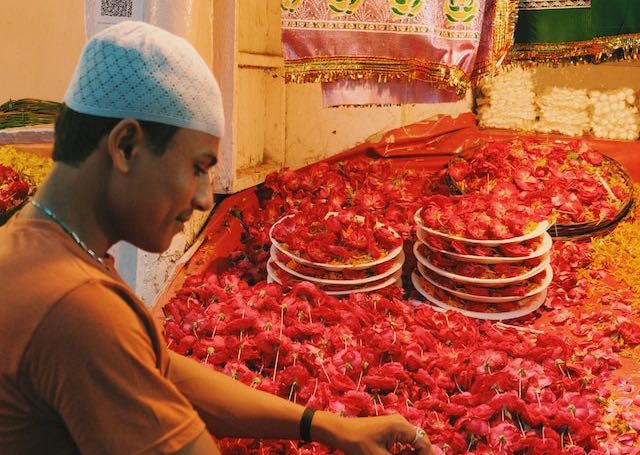 One of India’s greatest filmmakers, Satyajit Ray, would have turned 101 as India marks her 75th independence anniversary. Recognised with an Oscar Lifetime Achievement Award in 1992, Ray blazed the trail in cinema in multiple and complex ways. Kaushik Bhaumik reflects on some worldly complexities by the master storyteller and film-maker, and locates them in a wider context of film cultures in India at the time.
One of India’s greatest filmmakers, Satyajit Ray, would have turned 101 as India marks her 75th independence anniversary. Recognised with an Oscar Lifetime Achievement Award in 1992, Ray blazed the trail in cinema in multiple and complex ways. Kaushik Bhaumik reflects on some worldly complexities by the master storyteller and film-maker, and locates them in a wider context of film cultures in India at the time.
Recently, whilst teaching a module on Satyajit Ray, I presented a proposition at the end of two clusters of film-clips — one about the manner in which Ray cast his ‘favourite’ actor Soumitra Chatterjee throughout the 1960s, as a feckless, cowardly modern male, more often than not betraying the women whom he first seduces and then abandons when he is faced with the possibility of taking on the responsibility of proper relationships with them. And the other, about the common theme in Ray’s films of the boy who wants to run away from home into the big wide world, into a world of exotic marvels and adventures. I suggested that the two themes in Ray’s films form a couple that speak to one another in very productive ways.
In Apur Sansar (‘The World of Apu’, 1959), Soumitra, the grown-up Apu of the legendary Apu trilogy, abandons his child irresponsibly after his wife’s death at childbirth; and he betrays his lovers in Charulata (1964) and Kapurush (‘The Coward’, 1965), both played by Madhabi Mukherjee. He gets ‘slapped on the face’ by the girl he pursues romantically in Aranyer Din Ratri (‘Days and Nights in the Forest’, 1969) for his urbane cynicism when, in response to his query if they will meet again, she writes her phone number on a 5-rupee note denoting money as a crisis for Ashim (the character Soumitra plays): in the film, Ashim will struggle to reconcile his idealism with his strong need to be a corporate, moneyed man in order to be seen as an all-conquering heroic figure in society. For Ray, this was not so much about creating a villain as it was about showing the existential dilemma the modern male faces in his time, a fractured anti-hero of sorts caught in a contradictory pull between idealism and social success, between poetry and money, between heart and mind.
The other abiding theme in Ray’s film is that of the boy who wants to run away from home into a life of exotic adventure in the world, starting with the magnificent sequences of Apu running around his village, and Benaras, in the first two films of the Apu trilogy. In his Young Adult novella Phatik Chand (later filmed by Ray’s son Sandip, under Ray’s supervision), Ray invents the subterfuge of a boy who is kidnapped but ends up losing his memory in an accident and being befriended by an intinerant showman. This allows Ray to depict a bourgeois kid with the freedom to roam the world with a Muslim juggler, under a new name bestowed upon him by his itinerant friend Phatik Chand. They go to carnivals at the Maidan in Calcutta and travel India by train.
Indeed, Phatik Chand resembles that other great text of Ray’s — Sonar Kella (‘The Golden Fort’, 1974), adapted into a cult film by him in 1974 from one of his own ‘Feluda’ detective story series. Here Ray creates the subterfuge of having the young boy Mukul kidnapped by two scamsters on account of his powers of past-life regression that reveal that in an earlier life he had lived in a Rajasthani fort, in a world overflowing with precious gemstones. Through the film we follow Mukul soak in an exotic desert landscape dotted with forts, cities, camels, pastoralists, their songs, train tracks, colonial narrow-gauge trains until he is rescued by Feluda in a bravura action sequence set in the Golden Fort of Jaisalmer.
And of course who cannot but add the name of the greatest of Ray’s young boys who wants to run away from home into the big wide world outside: Feluda himself, Ray’s detective (played by Soumitra Chatterjee in the Feluda films directed by Ray), who chooses a profession so that he can fulfil his childhood wanderlust. His cases take him all over the world and he nurtures another boy who wants to run away from home — his cousin Topshe, passing on the tradition of Wanderlust that began with Apu.
Wanderlust, that very German Romantic ideal that Ray uses the foundational idea for his last film Agantuk (‘The Stranger’, 1991), deals with the life of the Stranger who, as a young boy, ran away from home to roam the world and finally live and work as an anthropologist amongst the Amerindians of Amazonia. Played by Utpal Dutt, the Stranger had been lost to the world for a long time, and thus his family (to which he returns for a short visit) cannot be sure if he indeed is their long lost uncle. That Ray himself does the ‘playback singing’ for the songs Utpal Dutt hums in Agantuk (and given the didacticism of his last three films) puts a final seal on the idea of Wanderlust as being a personal philosophy of Ray’s, and the philosophical basis for his cinema and fiction. The Stranger speaks of wanderlust as enabling the generosity of accepting the world’s diversity, of loving the peoples of the world and what they create while lampooning and criticising ‘civilisation’ relentlessly. In this very last film, Ray seems to be saying — this is what I am really about!
It could be argued that Agantuk puts the lid on Ray’s historico-philosophical pre-occupations, personal, historical and aesthetic, that run through his entire oeuvre. For, in the transformation of the feckless Apu, the boy who ran away from home, the one who abandoned his mother for the pleasures of the city’s kaleidoscopic pleasures, into the world-wandering Feluda, the detective unmoored from traditional domestic and social responsiblities, all presented through the persona of Soumitra Chatterjee, we find the modern Bengali male find a spine of conviction and commitment, a stabilisation of the relationship between the self and the world.
If the Apu/Soumitra persona is irresponsibly brutal in his abandonment of relationships in the films of the 1960s (to the point of cynically being a conduit for criminal activity in Abhijan (‘The Expedition’, 1962), then it is precisely because of his dubiously and confusedly trying to be both — a free-booting adventurer in the world, and doing the bhadralok thing — marrying and settling down to some kind of traditional social role. It is only when the latter desire to socialise, or rather the need to live up to social expectations, is given up in favour of epistemophilic Wanderlust that the Apu bildungsroman finds a resoultion.
*
In concluding, we need to emphasise a number of points about the critical tension between Wanderlust and society/civilisation in Ray cinema. First, this tension is not something that marks only the fiction of the Soumitra films but indeed points towards a more general social fact of modern Bengali masculinity enduring the process of modernisation. Indeed, Ray places this tension at the heart of the Bengal Renaissance in his period films — Devi (‘The Goddess’, 1960) and Charulata (1964).
Second, we would need to read Ray’s Wanderlust in the larger context of ‘vagabondage’ defining the ideal lyrical Indian citizen in Bombay cinema, in epochal films such as Awāra (‘The Vagabond’, 1951), Guide (1965) and Sholay (‘Embers’, 1975) — where auteurs such as Raj Kapoor and Dev Anand pose as the tramp and the wandering ascetic (respectively) as some kind of ideal existential ontology for selfhood and citizenship in an independent India.
Third, with Ray the issue of Wanderlust is not a gender-specific thing at all. It is Durga, Apu’s elder sister in Pather Panchali (‘The Song of the Road’, 1955), who is the original ecstatic wanderer of the universe, the one who teaches Apu to wander. Charulata, wife of the scholarly liberal bourgeois Bengali bhadralok gent, is restless at home, longing for the world outside which she espies with a pair of opera glasses looking through the slats of shuttered windows. She falls in love with her husband’s dashing poetry-spouting nephew precisely when she finds a resonance of her own Wanderlust in the young man.
Fourth, Wanderlust in Ray is above all an aesthetic resolution to the ontology of cinema itself. Phatik Chand is woven around the similarity of a travelling bioscope’s still imageries of scenes of the world and cinema. But more radically, Charulata’s views of the world through the shuttered windows are presented as one-shot vignettes of social types, a staple of early silent cinema. Men have full-length cinema encompassing grand lives, she does not.
And finally, Wanderlust is about cinema as defining the ‘modern’ as the medium that lives up to the democracy of vision that the modern opens us up to. If Wanderlust is the ontological siren-call of the modern, then cinema is the medium that stabilises wandering, keeps madness at bay, through an aesthetic act: the reason why Ray became a film-maker in the first place.
*
Wanderlust in Ray is a mysterious thing, something related to a lost paradise before the Fall where there is still an androgyny of bodies and desires across boys and girls which is then disrupted, leading to the disasters of the socialisation of the genders in civilisation. And indeed, it is cinema’s visual vividness of bodies that makes such a ambiguous corporeal foundation to society a viscerally felt reality as compared to other media. And men wander incomplete with their cinema of masculine solitude in the immemory of the fact that both cinema and the world are an androgynous Gemini. More and more so as things free up. There is of course a possible solution to sexual coupledom in Wanderlust presented in Abhijan — that between the male wanderer of the world (Soumitra Chatterjee again) and the courtesan of nomadic provenance. But then that is a horizon of history from which Ray and we are very far away from.
*
The views expressed here are those of the author and do not represent the views of the ‘South Asia @ LSE’ blog, the LSE South Asia Centre or the London School of Economics and Political Science.
This blogpost may not be reposted by anyone without prior written consent of LSE South Asia Centre; please e-mail southasia@lse.ac.uk for permission.
Banner image © Alex Litvin, ‘Projector Rays’, 2018, Unsplash.
The ‘India @ 75’ logo is copyrighted by the LSE South Asia Centre, and may not be used by anyone for any purpose. It shows the national flower of India, the Lotus (Nelumbo nucifera [Gaertn.]), framed in a graphic design of waves, and spindles depicting depth of water. The logo has been designed by Oroon Das.
*







